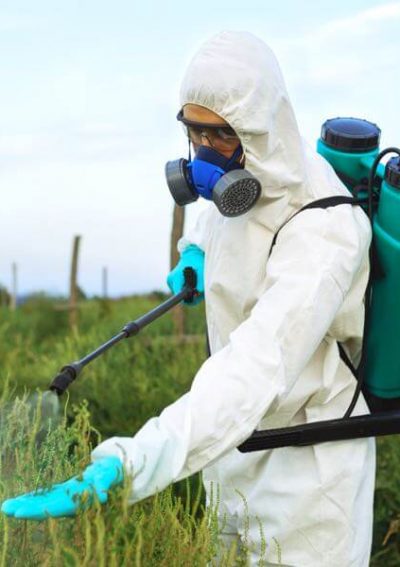Glyphosate
Glyphosate is an herbicide and the main ingredient in Roundup, a popular brand of weedkillers. Research shows a potential link between prolonged and high levels of exposure and an increased risk of certain cancers. Roundup has been the subject of thousands of lawsuits, many of which are ongoing.

What Is Glyphosate?
Glyphosate is the active ingredient in herbicide products, including Bayer’s Roundup. Glyphosate herbicides are widely used for weed control in U.S. agricultural settings, schools, public areas and home gardens.
The World Health Organization’s International Agency for Research on Cancer defines glyphosate as “probably carcinogenic to humans.” IARC analyzed data from more than 1,000 global studies. The U.S. Environmental Protection Agency, however, maintains that glyphosate isn’t likely to pose a risk to humans when current product label guidelines are followed.
Reports of illness have raised concerns about its safety. Many people who received a cancer diagnosis after regular use of Roundup have filed lawsuits against manufacturer Bayer. Courts have grouped thousands of these individual lawsuits into ongoing multidistrict litigation. Earlier cases have resulted in verdicts that awarded plaintiffs hundreds of millions of dollars.
Glyphosate Uses
Glyphosate is a nonselective herbicide that kills most plants with which it comes into contact. It’s widely used to control the growth of weeds in agriculture, forestry, home lawns, gardens and public spaces. It also has industrial areas.
Users typically spray glyphosate to apply it and the leaves of plants absorb it. From there, glyphosate travels to the plant’s roots, where it prevents the roots from absorbing nutrients the plant needs to grow.
Glyphosate also prevents plants from making certain proteins. The chemical blocks an enzyme pathway within the tissue of plants and some microorganisms, inhibiting growth.
Glyphosate Exposure Risks and Cancer
Recent research, including a WHO study, shows an association between high level and prolonged glyphosate exposure and an increased risk of developing non-Hodgkin lymphoma. In 2019, researchers at the University of Washington determined that high levels of use increases the risk of non-Hodgkin lymphoma 41%.
In 2023, the Journal of the National Cancer Institute published a study that showed people who have had exposure to glyphosate have early indicators of cancer risk factors in their bloodstream. In March 2023, another study showed that children with high levels of glyphosate exposure have indicators of body-wide inflammation and may have an increased risk of disease as young adults.
Inhaling glyphosate can cause eye and throat irritation or asthma. Swallowing it can cause burns in the mouth and throat, nausea, vomiting and diarrhea.
People may regularly consume small amounts of glyphosate residue on certain foods. The U.S. Food and Drug Administration found glyphosate residue on 59% of all tested samples of corn and soy. The amount of glyphosate was less than the EPA’s allowable levels and is generally considered safe.
Environmental Impact of Glyphosate
Glyphosate changes properties within the soil, affecting the growth of microorganisms. In some cases it causes an increase in microorganisms that can be dangerous to humans or other animals. Glyphosate can remain in the soil for months, depending on factors such as climate and soil pH.
When glyphosate breaks down it contaminates soil and water with the equally toxic byproduct aminomethylphosphonic acid. Other components of glyphosate-containing herbicides, such as surfactants, can also have a negative environmental impact. Glyphosate is highly toxic to some water animals, particularly invertebrates.
Certain farming practices can help reduce glyphosate’s harm to the environment. People shouldn’t use glyphosate where the spray can drift and cover surrounding plants. It’s also important to contain runoff and never dispose of this chemical in or near water sources.
Alternatives to Glyphosate
Glyphosate alternatives for weed control are available. Natural alternatives can come in spray formulations similar to Roundup. Others require manual application. Some people use multiple natural alternatives as part of a combined approach to weed control.
- Corn Gluten Meal: Researchers at Oregon State University found that corn gluten meal isn't an effective herbicide, but it may increase grass growth, making weeds appear fewer or grow more slowly.
- Herbicides Containing Acetic Acid: Acetic acid in concentrations of 5%-10% damages the outer layer of young plants, causing internal leakage and weakening the plant. Acetic acid can cause damage to the eyes or skin.
- Herbicides Containing Iron: Broad-leaf weeds absorb iron through leaves into the plant and will dry up but may require multiple applications. Iron-based herbicides can irritate eyes, skin or lungs.
- Herbicidal Soaps: These spray products damage the parts of the plant above ground, but they don’t generally pose toxicity issues except to aquatic species.
- Integrated Weed Management Systems: This practice combines natural approaches to weed control to limit the introduction and spread of weeds. It "chokes out" growing weeds, increasing surrounding plant growth and making it harder for weeds to adapt to varying growing conditions.
- Mulch: Applying wood chips or other mulch over garden beds before weeds have sprouted can block new shoots from the sun, causing them to die. Mulching is labor-intensive but poses no environmental or health risks.
Natural alternatives to glyphosate-based herbicides can be effective but don’t kill the plant’s root. Many have limitations to their use as well, and are only effective under certain circumstances or through multiple applications. Generally, combining alternative approaches is the most effective way to replace glyphosate.
14 Cited Research Articles
Consumernotice.org adheres to the highest ethical standards for content production and references only credible sources of information, including government reports, interviews with experts, highly regarded nonprofit organizations, peer-reviewed journals, court records and academic organizations. You can learn more about our dedication to relevance, accuracy and transparency by reading our editorial policy.
- Kaplan, S. (2023, March 1). Childhood exposure to common herbicide may increase the risk of disease in young adulthood. Retrieved from https://publichealth.berkeley.edu/news-media/research-highlights/childhood-exposure-to-common-herbicide-may-increase-the-risk-of-disease-in-young-adulthood/
- University of Maryland Extension. (2023, February 27). Corn Gluten for Crabgrass Control. Retrieved from https://extension.umd.edu/resource/corn-gluten-crabgrass-control
- Gillam, C. (2023, January 20). People exposed to weedkiller chemical have cancer biomarkers in urine – study. Retrieved from https://www.theguardian.com/us-news/2023/jan/20/glyphosate-weedkiller-cancer-biomarkers-urine-study
- U.S. Food and Drug Administration. (2022, February 28). Questions and Answers on Glyphosate. Retrieved from https://www.fda.gov/food/pesticides/questions-and-answers-glyphosate
- Ghandi, K. et al. (2021, August). Exposure risk and environmental impacts of glyphosate: Highlights on the toxicity of herbicide co-formulants. Retrieved from https://www.sciencedirect.com/science/article/pii/S2667010021001281
- Matozzo, V. (2020, October 27). Glyphosate Effection on Marine Invertebrates. Retrieved from https://encyclopedia.pub/entry/962
- Zhang, L. (2019, September). Exposure to glyphosate-based herbicides and risk for non-Hodgkin lymphoma: A meta-analysis and supporting evidence. Retrieved from https://www.sciencedirect.com/science/article/abs/pii/S1383574218300887
- Schalau, J. (2017, November 29). Corn Gluten Meal for Weed Control? Retrieved from https://cals.arizona.edu/yavapai/anr/hort/byg/archive/cornglutenmeal.html
- Koski, T. (2015, July). Natural Herbicides for Landscape Weed Management. Retrieved from https://cmg.extension.colostate.edu/wp-content/uploads/sites/59/2020/03/Natural-Herbicides-for-Landscape-Weed-Management-2018.pdf
- Wilen, C. (2012, January 3). Natural Herbicides: Are they effective? Retrieved from https://ucanr.edu/blogs/blogcore/postdetail.cfm
- Henderson, A.M. et al. (2010). Glyphosate General Fact Sheet. Retrieved from http://npic.orst.edu/factsheets/glyphogen.html
- Manitoba Agriculture. (n.d.). Integrated Weed Management: Making it Work on Your Farm. Retrieved from https://www.gov.mb.ca/agriculture/crops/weeds/integrated-weed-management.html
- International Agency for Research on Cancer. (n.d.). IARC Monograph on Glyphosate. Retrieved from https://www.iarc.who.int/featured-news/media-centre-iarc-news-glyphosate/
- Government of South Australia. (n.d.). Using Glyphosate. Retrieved from https://cdn.environment.sa.gov.au/landscape/docs/hf/responsible-chemical-use-using-glyphosate-fact.pdf
Calling this number connects you with a Consumer Notice, LLC representative. We will direct you to one of our trusted legal partners for a free case review.
Consumer Notice, LLC's trusted legal partners support the organization's mission to keep people safe from dangerous drugs and medical devices. For more information, visit our partners page.
855-605-1792
